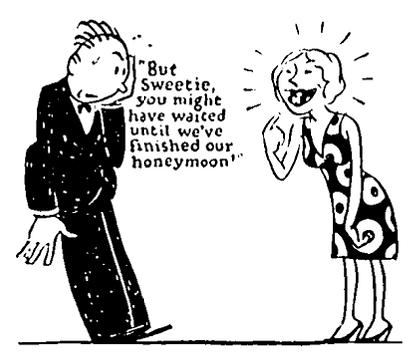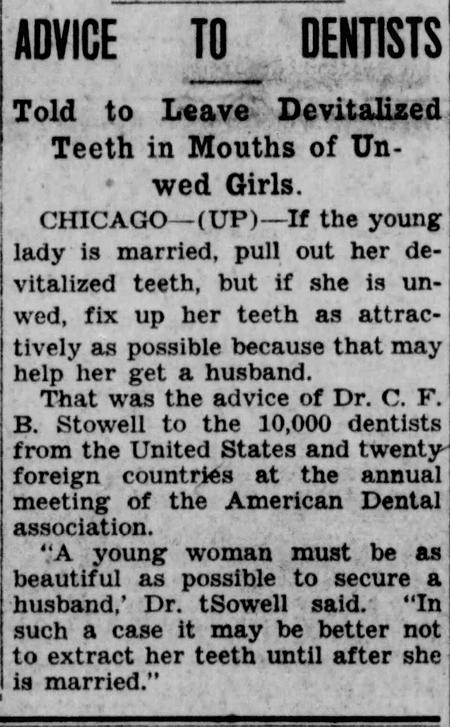Tooth Extraction and Marital Status
1930: Dr. C.F. B. Stowell, speaking to fellow dentists at the annual meeting of the American Dental Association, advised that if a young woman was unwed it would be better not to pull all her "devitalized teeth," because she "must be as beautiful as possible to secure a husband." But if the woman was married -- go ahead and pull those teeth!

Lurking behind this statement, I believe, was the idea of "Focal infection theory." According to this theory, which was widely held by dentists in the 1920s and 30s, infected teeth were responsible for a variety of diseases including arthritis, cancer, and mental illness. So if there was any suspicion that a tooth was infected, it was better to pull it. In fact, it was often better to pull all a patient's teeth, whether or not they showed any signs of problems, just to be safe.
From wikipedia:


Life - Feb 14, 1930
Lurking behind this statement, I believe, was the idea of "Focal infection theory." According to this theory, which was widely held by dentists in the 1920s and 30s, infected teeth were responsible for a variety of diseases including arthritis, cancer, and mental illness. So if there was any suspicion that a tooth was infected, it was better to pull it. In fact, it was often better to pull all a patient's teeth, whether or not they showed any signs of problems, just to be safe.
From wikipedia:
Unsuspected periapical disease was first revealed by dental X-ray in 1911, the year that Frank Billings lectured on focal infection to the Chicago Medical Society. Introduced by C Edmund Kells, the technology became used to feed the "mania of extracting devitalized teeth"... Many dentists were "100 percenters", extracting every tooth exhibiting either necrotic pulp or endodontic treatment, and extracted apparently healthy teeth, too, as suspected foci, leaving many persons toothless. A 1926 report published by several authors in Dental Cosmos—a dentistry journal where Willoughby Miller had published in the 1890s—advocated extraction of known healthy teeth to prevent focal infection. Endodontics nearly vanished from American dental education. Some dentists held that root canal therapy should be criminalized and penalized with six months of hard labor.

Lincoln Evening Journal - Jan 16, 1930
Comments
Wow! Barefoot, pregnant and toothless! What a life for a female to look forward to according to the chauvinistic worldview.
Posted by KDP on 04/08/17 at 12:47 PM
Commenting is not available in this channel entry.

Category: 1930s | Teeth